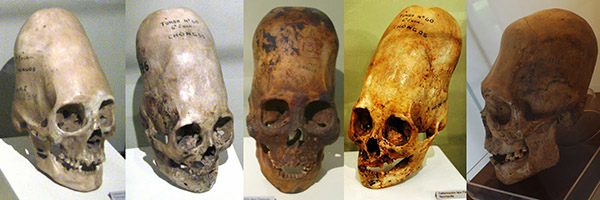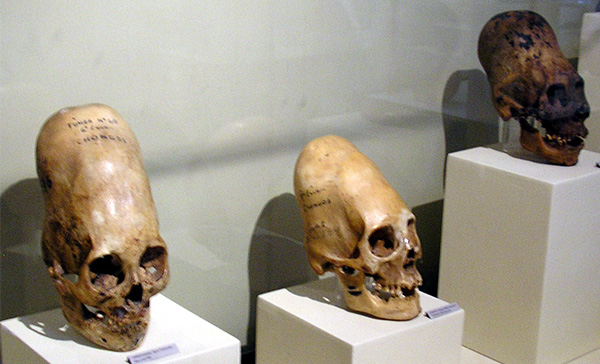
The hypogeum of Hal Saflieni contained the bodies of over 7,000 people, a 'speaking chamber', trilithons, lintelled-doorways, a large cistern and a 'holy of holies' surrounded by 'embryonic' chambers.
What experiments were conducted in this bizarre and mysterious place?

Click on image to enlarge
It was discovered by accident in 1902 when workers cutting cisterns for housing development broke through its roof. The workers tried to hide the temple at first, but eventually it was reported.
It seems that Hal Saflieni hypogeum was not a "normal, collective prehistoric rock-cut tomb".
Long time ago, in the megalithic temple of Hal Saflieni, in Malta, men with large and odd cranial volume were buried in a matrix of red earth.

These skulls seem to belong to a strange race and if properly analyzed, could create an ideal link between the ancient Mesopotamian and Egyptian cultures and a race of sacerdotal men identified with the snake.
The odd Malta skulls that are strangely elongated have a deformity (dolichocephalous) known to be at least 3000 BC, which is still - pathologically - very unique.
Researchers have long wondered if the skulls constitute the result of an ancient genetic mutation between different races or perhaps something else much more bizarre, taking place on Malta.
"One of the skulls... is entirely lacking in the fossa median - the cleary visible 'join' that runs along the top of the head where two plates of bone are separated in infancy (thus facilitating the process of birth) but later joined together in adulthood...What would people with skulls like that have looked like during life?
How could they survived birth and grown to adulthood?" (G. Hancock, "Underworld")

A number of such skulls were unearthed in different temples at Tarxien, Ggantja and Hal Saflieni, Malta.
Curiously, after they were displayed in the Archeological Museum of the Valletta, these unique and rather controversial artifacts were removed.
"The museum kept at one point had eleven elongated skulls in 1971; then there were seven; at last count, only six remain. As the losses are unexplained (by default), a number of conspiracy theories are in circulation in Malta that argue that the museum “wants” these bones to disappear – suggesting they somehow are able to provide evidence against the official story about what the Hypogeum is," according to the late Philip Coppens, a Belgian investigator of ancient history and mysteries. |

The skulls were all found in the Hal Saflieni Hypogeum, where a sacred well was dedicated to the Mother Goddess and where also the small statue of a sleeping goddess was found, associated to a relic with a snake inscription on it. The skulls were brought out of their box one at a time. They were kept for about 15 years far from the sight of public and researchers willing to investigate them.
The anomaly of the skulls were clearly visible. The cranium had a lengthened posterior part of the skullcap (dolichocephalous) besides the lack of median knitting, technically named "sagitta".
According to scientists, this kind of anomaly do not have analogous pathological cases in international medical literature.
Did the skulls belong to beings representing another race? What was their origin?
As many as 7000 skeletons were dug out of the Hal Saflienti hypogeum and examined by Themistocles Zammit in 1921, presented artificially performed deformations.
According to the Maltese archeologists Anthony Buonanno and Mark Anthony Mifsud, the skulls represented another race although C-14 or DNA exams haven't yet been performed. They could originate from Sicily.

Many of the skulls found in the hypogeum showed a natural genetic tendency to the occurrence of elongation and were integrally involved in the activities of the temple builders of the time. Other skulls, for example, those found in the Brochtorff circle (Hypogeum II), are considered to have had their heads bandaged in order to produce their cranial deformities.
"One skeleton that was "unburied by the archeologist, Brochtorff Circle, shows clear signs of intentional deformation through bondage. These deformations occurred for various reasons: initiations, matrimonies, solar rituals or punishments for social crimes or transgressions.Why such persistence in tormenting one's own body? ask Forgione.
All the tribal apparatus of incisions, perforations, partial or total removals, cauterizations, abrasions, insertions of extraneous bodies in muscles, like the modification of bodies for magical, medical or cosmetic purposes, were part of cruel practices in such, but "with best intentions" for the community." (A. Forgione, Atlantis Rising Magazine, Vol.43, "The Mystery of Malta's Long-Headed Skull").
Was there any connection between the tribal rituals and the men of the lengthened cranium? Could it be possible that, as in other cultures, successive populations tended to deform their infant's heads in order to make them similar to this race of "serpent priests"?
In Malta, all this was practiced by a mysterious populace that erected gigantic temples to the Mother Goddess between 4100 and 2500 B.C. The presence of these skulls might be that of the last exponents of the most ancient sacerdotal caste that built the megalithic temples and, never having blended with the local populations, had continued reproducing through the millenniums within familiar unions (as was the usual practice among the elite) and consequently impoverished its genetic patrimony until inevitable pathologies manifested, finally disappearing.
The hypogeum Hal Saflieni was not a unique structure; it was accompanied by another one known as the Xaghra Stone Circle, located on the nearby island of Gozo and yet another hypogeum of Santa Lucia, located less than a kilometer away.
It was excavated in the early 1970s and then sealed up again and covered by a modern cemetery.
Why? And why did the workers - cutting cisterns for housing development - try to hide the temple at first?
Obviously, they knew more about secrets of Hal Saflieni. We, on the other hand, know very little about the purpose of the hypogeum Hal Saflieni and similar mysterious sites on Malta.
Coppens cites an interesting account:
"Miss Lois Jessup, working for the British Embassy in Malta, wrote an account of an experience she had inside the Hypogeum. She described how on her first visit, she convinced the guide to allow her to investigate one of the so-called "burial chambers" near the floor of the last chamber in the lower level.
In her own words, she asked “What's down there”, pointing to a small opening off the walls. To quote from Jessup’s account: “‘Go there at your own risk, and you won't go far,’ he replied. ‘I was wearing a dress with a long sash that day and as I decided to lead the group I asked the fellow behind me to hold onto it. So, with half-burnt candles in our hands the four of us started through that low, narrow passage, groping and laughing our way through. I came out first, of course, onto a ledge pathway only two feet wide, with a sheer drop of fifty feet or more on my right and the wall on my left.
I took a step forward, keeping close to the rock wall side. The person behind me, still holding on to my sash, was still in the tunnel. I held my candle higher and peered down into the abyss, thinking that with this dangerous drop it was better not to go on further without a guide. Then I saw about twenty persons of giant stature emerge from an opening deep below me. They were walking in single file along another narrow ledge down below.
Their height I judged to be about twenty to twenty-five feet, since their heads came up about half way on the wall on the opposite side of the cave. They walked very slowly, taking long strides. Then they all stopped, turned and raised their heads in my direction. All simultaneously raised their arms and with their hands beckoned to me."
"The movement was something like snatching or feeling for something, as the palms of their hands were turned down.”Her friends then pulled her back into this reality, though a sudden draft of air extinguished her candle, making her panic. A few days later, one of the friends of the excursion called her:
“Remember that tunnel you wanted to explore in the Hypogeum? Well, it says here in the local paper that a schoolmaster and thirty students went exploring and apparently got as far as we got. They were roped together, with the end of the rope tied to the opening of the cave. As the last student turned the corner where your candle blew out the rope was clean cut. None of the party was found because the walls caved in.” Apparently, for several weeks, the cries of the children could be heard emanating from the underground, but none were ever recovered alive..."
See also:
Unknown Highly Advanced Civilization Created Malta’s Cart Ruts With Sophisticated Machinery
Cover-ups And Suppression Of Archaeological Evidence
Read more: http://www.messagetoeagle.com/maltalongheaded.php#ixzz36msm2PDd



